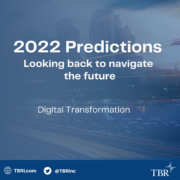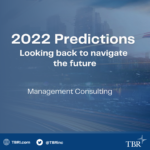Digital transformation cannot escape tech despite vendors’ evolving value propositions
Complexities in developing and managing digital transformation (DT) have fueled tremendous opportunity for vendors across IT and services over the past five to seven years. With the market likely facing another slowdown in the next six to nine months, it will become even more imperative for vendors to rely on the trust and relationships they have built within their clients’ organizations.
With the pendulum swinging back and forth between where DT programs originate — from top-down to grassroots and back — vendors have had the chance to build portfolio and sales motions that appeal to broader buyer personas.
Prediction No. 1: As clients graduate beyond digital transformation, vendors scramble to stay relevant
Principal Analyst Boz Hristov: This trend evolved through the first nine months of 2022. While digital transformation has been a trend for years now, the reality is that more people have talked about it than have taken action, with a plethora of pilots but a scant number of transformations at scale — and most buyers have yet to realize that addressing change management issues frequently trumps addressing technology complexities.
Resolving internal politics creates an opening for consultancies. However, consultancies must be careful about how they approach such opportunities as the expectations of the stakeholder ecosystem have evolved and legacy sales tactics might not work in today’s environment and could potentially backfire and pressure trust and brand.
Executing on their promises without making buyers feel like they are being sold on a particular solution will enable consultancies to build the foundational trust necessary to increase client stickiness, resulting in increasing managed services sales, the North Star that vendors from across the spectrum seem to be following these days.
Additionally, opportunities around Agile coaching, especially among buyers who are further along in their DT programs, continue to create openings for IT services vendors and consultancies. To succeed, vendors must account for the evolving nature of in-house IT departments, which often face internal challenges and may sacrifice tech to gain leadership buy-in and sponsorship of a particular program. We do not anticipate that these trends will slow down and/or be resolved anytime soon, especially as many buyers are just starting to invest in their DT programs.
Prediction No. 2: Funky chairs only matter if you can physically sit in them — The resurgence of innovation and transformation centers
Practice Manager and Principal Analyst Patrick M. Heffernan: If IT services and consulting clients often failed to meet their highest expectations around innovation pre-pandemic, relying on screens to innovate only exacerbated the gap between incremental change and true transformation. Post-pandemic, both clients and the people leading innovation and transformation engagements want to return to in-person sessions, understanding that creativity, serendipity and ingenuity rarely happen in Zoom or Teams meetings.
Three cautionary notes on the stampede back into physical experience centers for design thinking sessions:
- The “been there, done that” attitude started to show up in our Voice of the Customer research — and while clients may be clamoring to be in-person again, they are going to want assurances their time will be well spent.
- While we are seeing a resurgence of in-person engagements, we do not expect a similar push to open additional new physical centers, at least not in the near term. The pandemic allowed IT services vendors and consultancies to hone their virtual delivery skills and the metrics around these centers — both of which may contribute to reduced enthusiasm for new physical centers.
Hybrid isn’t it. We were wrong when we predicted all parties involved would embrace hybrid engagements, mixing on-site and remote participants. While some vendors took that approach in the latter months of the pandemic, most now realize the most effective sessions come from either all in-person or all-remote engagements. In hybrid, one set of participants inevitably get a suboptimal experience, so an increasing number of vendors are abandoning hybrid altogether.
Prediction No. 3: New generation of business leaders expect business transformations, not digital ones
Boz: TBR recognizes that both technology and services vendors — particularly those that are publicly traded and must meet Wall Street’s expectations for profitable growth — will not slow their pace of introducing new concepts or portfolio offerings. New opportunity areas like sustainability and the metaverse are on the horizon, and we have observed virtually every vendor we cover make either a large investment or a splashy PR announcement in one or both of these areas.
While these investments drive technological progress, vendors must be careful about how they pitch such offerings, as buyers are usually focused on short- to mid-term issues like transforming business models rather than long-term boiling-the-ocean type of issues. Evolving business priorities vary by industry, which puts further pressure on vendors to demonstrate their value without coming across as too generally focused.
At the same time, buyers seek to diversify risk, which further compels vendors to think about operating as an ecosystem enabler, rather than adopting a “we can do it all” mindset. In TBR’s view, the most successful vendors are those that stay true to their strengths instead of coming across as pushy salespeople. This approach enables them to gradually expand mindshare and wallet share by engaging in challenging discussions about risk sharing rather than simply taking orders.
Getting internal buy-in from vendors’ leadership and establishing a runway that is long enough to try such tactics without being pressured to meet 90-day reporting goals will be key.
Predictions is an annual TBR series examining market trends and business changes in key markets. 2022 covered segments included cloud, telecom, devices, data center, and services & digital.

 Technology Business Research, Inc.
Technology Business Research, Inc. Technology Business Research, Inc.
Technology Business Research, Inc. Technology Business Research, Inc.
Technology Business Research, Inc.